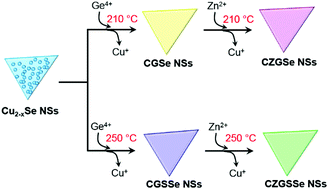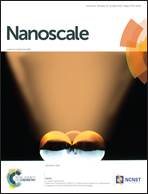Bandgap tunable colloidal Cu-based ternary and quaternary chalcogenide nanosheets via partial cation exchange†
Abstract
Copper based ternary and quaternary semiconductor nanostructures are of great interest for the fabrication of low cost photovoltaics. Although well-developed syntheses are available for zero dimensional (0D) nanoparticles, colloidal synthesis of two dimensional (2D) nanosheets remains a big challenge. Here we report, for the first time, a simple and reproducible cation exchange approach for 2D colloidal Cu2GeSe3, Cu2ZnGeSe4 and their alloyed Cu2GeSxSe3−x, Cu2ZnGeSxSe4−x nanosheets using pre-synthesized Cu2xSe nanosheets as a template. A mechanism for the formation of Cu2−xSe nanosheets has been studied in detail. In situ oxidation of Cu+ ions to form a CuSe secondary phase facilitates the formation of Cu2−xSe NSs. The obtained ternary and quaternary nanosheets have average lateral size in micrometers and thickness less than 5 nm. This method is general and can be extended to produce other important ternary semiconductor nanosheets such as CuIn1−xGaxSe2. The optical band gap of these nanosheets is tuned from 1 to 1.48 eV, depending on their composition.


 Please wait while we load your content...
Please wait while we load your content...